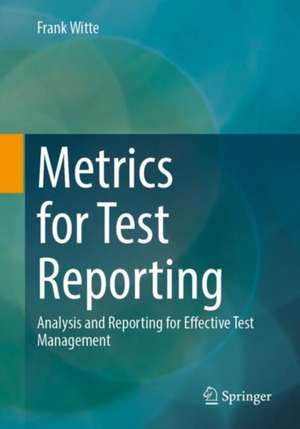Metrics for Test Reporting: Analysis and Reporting for Effective Test Management
Autor Frank Witteen Limba Engleză Paperback – 29 iun 2024
Starting with the historical development of test reporting, the author explains the fundamental benefits of metrics and provides an overview of the different types of metrics and how they can be used effectively in software testing. He shows how a particular metric can be individually adapted to the software to be tested, starting with the test specification and test execution through to the development of test coverage, and how this can lead to test automation. He also presents the advantages and disadvantages of those test metrics that are based on defects, i.e. that measure the number of defects, the defect density and the development of defects over time.
With this detailed examination of test reporting, the author provides an optimal basis for evaluation, which not only allows the assessment of which test metric should be used for which purpose or which individual project situation, but also what the particular problems of an individual metric for test reporting may be and how these problems can best be solved. This practical guide is therefore primarily aimed at employees in IT projects, such as project managers, software testers and developers, but business and technology consultants as well as lecturers at colleges and universities will also find an exciting insight into various software testing methods.
Preț: 316.03 lei
Preț vechi: 395.04 lei
-20% Nou
Puncte Express: 474
Preț estimativ în valută:
60.47€ • 63.30$ • 50.33£
60.47€ • 63.30$ • 50.33£
Carte tipărită la comandă
Livrare economică 27 martie-02 aprilie
Preluare comenzi: 021 569.72.76
Specificații
ISBN-13: 9783658440053
ISBN-10: 3658440058
Ilustrații: XIV, 237 p. 67 illus., 57 illus. in color.
Dimensiuni: 168 x 240 mm
Greutate: 0.57 kg
Ediția:2024
Editura: Springer Fachmedien Wiesbaden
Colecția Springer
Locul publicării:Wiesbaden, Germany
ISBN-10: 3658440058
Ilustrații: XIV, 237 p. 67 illus., 57 illus. in color.
Dimensiuni: 168 x 240 mm
Greutate: 0.57 kg
Ediția:2024
Editura: Springer Fachmedien Wiesbaden
Colecția Springer
Locul publicării:Wiesbaden, Germany
Cuprins
Definition, history and use of metrics.- Classification of metrics.- Complexity measures.- Norms and standards for measurements.- Use of different representations.- Use of metrics.- Software metrics.- Metrics for software quality.- Requirements-based test metrics.- Metrics for effort estimation.- Metrics for test preparation and follow-up.- Metrics for test planning.- Metrics for different test levels.- Requirements-based test metrics.- Metrics for effort estimation.- Metrics for test preparation and follow-up.- Metrics for test planning.- Metrics for different test levels.- Metrics for measuring test coverage.- Test case-based metrics.- Test object-based metrics.- Test case-based metrics.- Test object-based metrics. Test object-based metrics.- Metrics for test execution.- Metrics for performance and load testing.- Metrics for test automation.- Cost-based test metrics.- Test productivity metrics.- Goal question metric.- Defect-based test metrics.- Metrics for test documents.- Metrics for usability tests.- TPI Next.- Metrics for end-of-test criteria.- Metrics and test reporting.- Comparison of test metrics.- Problem solving for the use of test metrics in testing.- Effect of reporting with the help of test metrics.
Notă biografică
Frank Witte has many years of experience in software testing in various companies and industries. He is constantly faced with the challenge of presenting progress, but also problems, in the testing process to project leaders and management and summarizing his results in reporting with the help of figures.
Textul de pe ultima copertă
The book presents various test parameters and metrics that can be used to vividly illustrate the progress of software development as part of a software test and to easily identify the need for action. Key parameters and index values for successful reporting - also for management - are explained in detail. These can vary depending on the type of issue, project scope or project status. The author provides important background knowledge. This practical guide is therefore primarily aimed at employees in IT projects, such as project managers, software testers and developers, as well as business and technology consultants. Lecturers at colleges and universities will find an exciting insight into various software testing methods.
Frank Witte has many years of experience in software testing in various companies and industries. He is constantly faced with the challenge of presenting progress, but also problems, in the testing process to project leaders and management and summarizing his results in reporting with the help of figures.
The translation was done with the help of artificial intelligence. A subsequent human revision was done primarily in terms of content.
Caracteristici
A guide to creating metrics for progress monitoring in software development With many formulas for the development of test metrics The ideal supplement to the author's book "Test Management and Software Testing"
